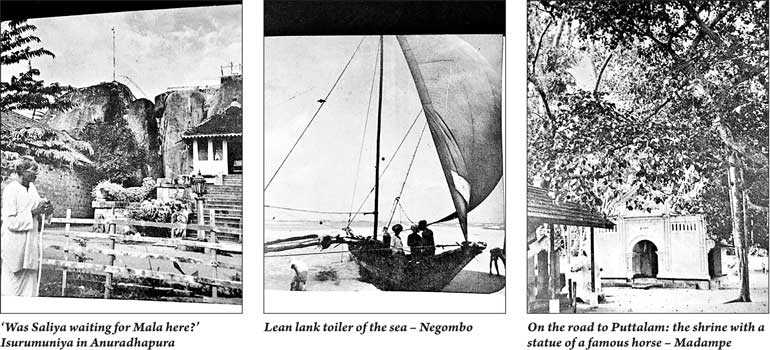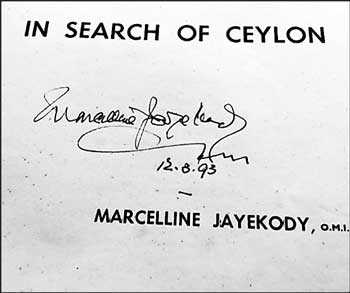Sunday Jul 06, 2025
Sunday Jul 06, 2025
Saturday, 18 January 2020 00:04 - - {{hitsCtrl.values.hits}}


“Violets and forget-me-nots grow in our morning seas. In the evening seas, roses. Not every ship that sailed to Ceylon came to gather forget-me-nots and roses.
“Four-and-half centuries ago Lorenzo de Almeida, a Portuguese pirate, cut through these forget-me-nots searching for ships of cinnamon and other spices. Europe needed the spices to keep its winter meats safe. The Muslims who were clever sailors took the spices ships as far as Arabia. From there caravans carried the precious cargo to different countries in Europe. In exchange, the daring seamen brought back gold and silver. Lorenzo wished to capture this trade. His kinsmen, the Portuguese, were under Mohammedan rule for eight centuries. Revenge was in his heart. He would destroy the Muslims, find the lands of the spices and expand his country’s empire.
“As he approached Ceylon, Lorenzo found that the forget-me-not fields of sea were under a spell. He was caught in a storm and driven south. He landed in Galle. This was a very ordinary event but it changed the destiny of Ceylon. The Portuguese occupied its coast for one hundred and fifty years, closely.”
Thus Father Marcelline Jayekody describes the arrival of the Portuguese prior to taking the reader on a journey down south.
“Lean, lank canoes line up on the shore with folded wings waiting for the call of the sea. Far away the blue, burning sky bends down to touch the fringe of the fading sea. One cannot miss the play of the light on the water and the colours that come and go. Often the sea surface looks like an exhibition of Persian carpets and Kashmir sarees laid for a carnival of beauty.”
Referring to the Beruwala bay as “a cup cut in moonstone,” he gazes at the Balapitiya shore where he sees a “the blue bowl of a bay with a rocky inlet”. He notices “a gentle breeze blowing bringing the subtle, bitter perfume of the sea and the land….and a mother singing a lullaby to the rhythm of the sea”. Describing Galle as “the Sleeping Beauty of Ceylon”, he writes how Galle sleeps and dreams of the days when the princes of Ruhuna ruled Ceylon and fought for her glory, when seamen came there from Phoenicia, Greece, Arabia and Rome.
Seeing Ruhuna as a country full of history, legends and stories where no invading Indian army ever set foot, he moves to Devi-Nuwara - the city of the gods, Kirinda where Vihara Maha Devi came floating on the sea, and the mysterious Kataragama where people walk on fire. “There is no better drummer than the drummer of Ruhuna. There is no whiter curd than the curd of Ruhuna. There is no sweeter treacle than the treacle of Ruhuna”.
Father Jayekody refers to the night in Negombo as “a perpetual carnival of moonlight, torchlight and lamplight” and a study in black and white during the day. “The children of Negombo are hardy. From the cradle they go to the sea. The men are made of bronze. They are not born. They are sculptured by the sea. The women are straight and elegant. The waves of the sea are in their movements.”
 After the temple of the horse of King Taniawalla – a local prince of five centuries ago – he sees “a lovely lagoon with its shadows of bars and sunshine” in Chilaw. Puttalam is a measureless tent with a blue canvas drawn over it.
After the temple of the horse of King Taniawalla – a local prince of five centuries ago – he sees “a lovely lagoon with its shadows of bars and sunshine” in Chilaw. Puttalam is a measureless tent with a blue canvas drawn over it.
“Push back a thousand years and Puttalam will be revealed in all its legendary glory. One would see Vijaya, the unruly prince of Bengal, who came with his followers to begin the story of Ceylon from the beginning. One would see Kuveni, the demon princess, meeting Vijaya.
“If the sounds of those could have been summoned one would hear the throb of the drums, the sound of conch shells and the beat of cymbals. That would be the wedding of Vijaya and Kuveni, in terms of sound. It is a lonely, lovely road from here to Anuradhapura and from there to Jaffna. There is jungle on either side of the road with wild animals and birds of many kinds: peacocks and parrots and jungle fowl; bears and elephants. Groups of monkeys can be seen on trees and sometimes a leopard on the road.
“There is a bouquet of wildflowers. There are millions of butterflies scattering their beauty in the air. There are miles of dark road lying across the jungle to be wooed and conquered.”
He thus takes the reader through the “Green Hills of Lanka”, “A hut in the orange grove”, Diyaluma, World’s End, The Ancient Devale (at Aluthnuwara) to Kandy and Down South.
I repeat – ‘In Search of Ceylon’ is a most fascinating book.
Discover Kapruka, the leading online shopping platform in Sri Lanka, where you can conveniently send Gifts and Flowers to your loved ones for any event including Valentine ’s Day. Explore a wide range of popular Shopping Categories on Kapruka, including Toys, Groceries, Electronics, Birthday Cakes, Fruits, Chocolates, Flower Bouquets, Clothing, Watches, Lingerie, Gift Sets and Jewellery. Also if you’re interested in selling with Kapruka, Partner Central by Kapruka is the best solution to start with. Moreover, through Kapruka Global Shop, you can also enjoy the convenience of purchasing products from renowned platforms like Amazon and eBay and have them delivered to Sri Lanka.
Discover Kapruka, the leading online shopping platform in Sri Lanka, where you can conveniently send Gifts and Flowers to your loved ones for any event including Valentine ’s Day. Explore a wide range of popular Shopping Categories on Kapruka, including Toys, Groceries, Electronics, Birthday Cakes, Fruits, Chocolates, Flower Bouquets, Clothing, Watches, Lingerie, Gift Sets and Jewellery. Also if you’re interested in selling with Kapruka, Partner Central by Kapruka is the best solution to start with. Moreover, through Kapruka Global Shop, you can also enjoy the convenience of purchasing products from renowned platforms like Amazon and eBay and have them delivered to Sri Lanka.